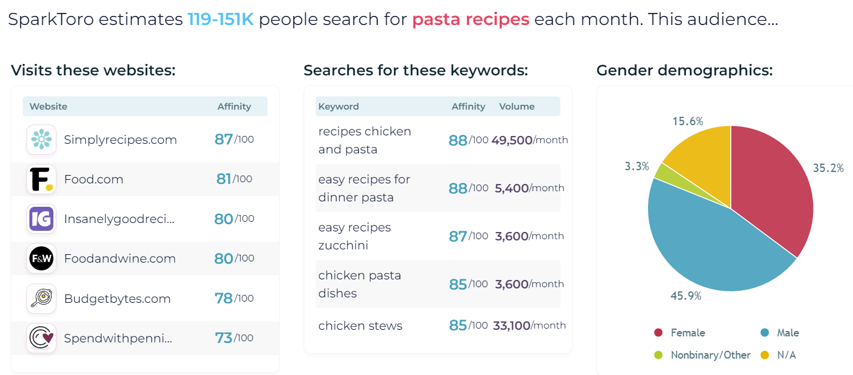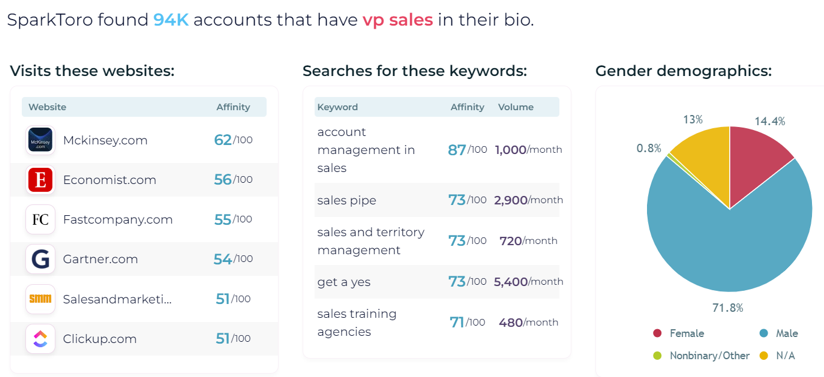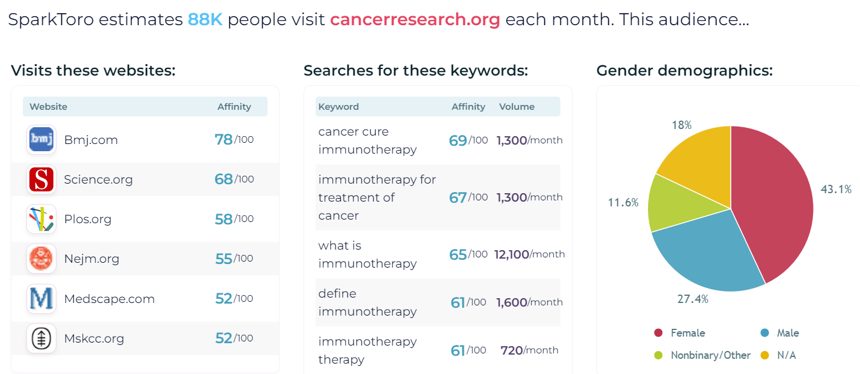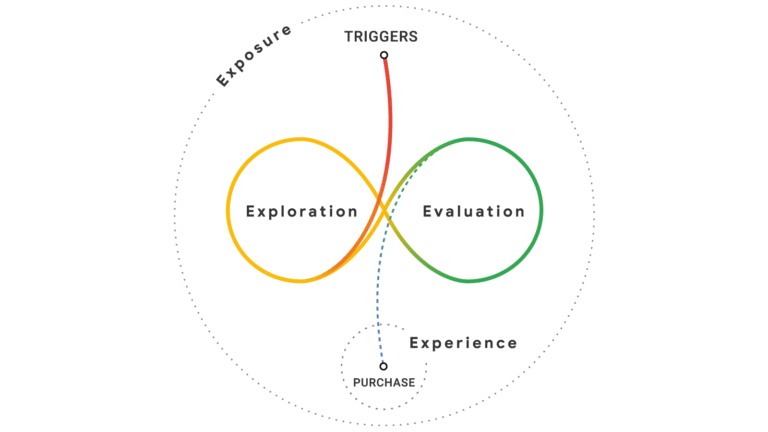

Last updated on

Having authored content on search engine optimization (SEO) for over two decades, reflecting on the evolution of actionable insights, it’s evident that continuous adaptation is imperative in today’s dynamic landscape.
The rapid advancement of AI in SEO has heightened the challenge of staying abreast of developments. Amidst this flux, it’s essential to acknowledge the transient nature of advice in the realm of Search.
As our tasks multiply, surpassing available resources, prudent allocation becomes paramount.
Thus, what are the paramount strategic SEO insights and tactical directives to prioritize in 2024 and beyond?
Since 2002, I’ve been leveraging keyword research tools to enhance my SEO efforts. However, it wasn’t until 2020 that I integrated SparkToro, an audience research tool, into my strategy.
Traditional keyword research primarily provided insights into search volumes for specific keywords. With the introduction of SparkToro V2, the scope expanded significantly. Now, alongside search data, it furnishes valuable information about the audience associated with a keyword, including their bio keywords and website visits.
This advancement marks a pivotal shift, coinciding perfectly with the imperative for SEO professionals to develop comprehensive user, buyer, marketing, and customer personas, as elucidated in my earlier work on how Customer Personas Can Transform SEO, PPC, and Content Marketing.
To truly make an impact in the field, SEO practitioners must move beyond mere optimization for a generic audience. Why? Because the concept of a one-size-fits-all approach no longer holds sway.
For years, digital marketers have honed their skills in targeting ads towards specific demographic segments, intents, and interests. In contrast, SEO professionals relied on deducing user intent solely from query keywords—a methodology that often left much to speculation.
Can we really blame them? Before the advent of SparkToro, keyword research tools provided insights only into the “what” of user searches, neglecting the crucial “who” aspect.
Now, with SparkToro’s capabilities, SEOs and content marketers gain unprecedented access to demographics, interests, and influential information sources shaping user intent.
Consider this scenario: imagine a B2C company or client curious about the demographics behind searches for “pasta recipes.” SparkToro reveals that between 119,000 to 151,000 individuals search for “pasta recipes” each month, offering valuable demographic insights previously unattainable through traditional keyword research tools.
The tool also indicates that 45.9% of individuals are identified as male, 35.2% as female, 3.3% as nonbinary/other, and 15.6% do not disclose their gender in their social media bios.
Furthermore, they frequent websites such as SimplyRecipes.com and Food.co, and engage in searches for keywords like “recipes chicken and peas” and “easy recipes for dinner pasta.”

Alternatively, consider targeting the niche audience of “VP of Sales” for your B2B company or client.

According to SparkToro, there are approximately 94,000 individuals who have “vp sales” mentioned in their social media bios. Among them, 71.8% are male, 14.4% are female, 0.8% are categorized as binary/other, and 13% do not specify their gender in their social media bios.
This audience is actively searching for keywords such as “account management in sales” and “sales and territory management.”
Finally, suppose you’re engaged in pro bono work for the Cancer Research Institute (CRI).
You could inform CRI that CancerResearch.org receives 88,000 monthly visitors, with 43.1% identifying as female, 27.4% as male, 11.6% as binary/other, and 18% not specifying their gender in their social media bios.
This audience also frequents BMJ.com and Science.org, while actively searching for topics like “cancer cure immunotherapy” and “immunotherapy for treatment of cancer.”

With this insight, you have a clear direction for creating original, helpful content tailored to their needs.
It’s essential to emphasize that while conducting audience research is valuable, it doesn’t replace keyword research. However, it does empower SEOs to avoid the pitfall of optimizing content solely for the “average” website visitor, which often leads to decreased conversion rates.
Google determines the relevance of search results by discerning the underlying intent of users’ queries.
With a deeper comprehension of your audience’s preferences, you’re better equipped to interpret the significance behind their search inquiries.
It’s noteworthy that Google invested over five years in refining language models to decipher how users’ search terms align with the most pertinent content.
Google sheds light on its approach to understanding query intent:
“When users input terms like ‘cooking’ or ‘pictures,’ our algorithms deduce that displaying recipes or images would likely fulfill their intent.
In the case of searches conducted in French, the majority of displayed results will be in that language, considering the user’s probable preference.
Furthermore, our systems are adept at recognizing many queries with a local context. For instance, a search for ‘pizza’ may yield results pertaining to nearby eateries offering delivery services.”
Google also emphasizes:
“When users search for trending keywords, our systems recognize the importance of providing up-to-date information over older pages. Hence, inquiries related to sports scores, company earnings, or any other rapidly evolving topics will display the latest updates.”
However, it’s essential not to become overly fixated on individual details and lose sight of the bigger picture. I suggest revisiting an article I penned on December 16, 2020, titled “The Future of SEO Lies in the ‘Messy Middle’ of the Purchase Journey.”
Alternatively, to streamline your reading, here’s the strategic SEO insight shared by Alistair Rennie and Jonny Protheroe from Google’s consumer insights team in Great Britain, condensed from their 1,000-word article summarizing a 98-page report:
“People typically seek information about products and brands within a category and then proceed to evaluate their options. This process involves two distinct mental modes within the ‘messy middle’: exploration, which involves broadening one’s scope, and evaluation, which entails narrowing down choices.
The myriad of online activities individuals engage in, spanning search engines, social media, aggregators, and review platforms, can be categorized into these two mental modes.”
Hence, when analyzing numerous queries, you can categorize them into two main groups: Exploration and Evaluation.

With two buckets of queries at your disposal, the approach is to craft tailored content for each segment during the “messy middle” of their purchase journey. This entails creating distinct pages catering to different user personas, buyers, marketers, and customers targeted by your company or client.
Every seasoned SEO professional is well-versed in Google’s stance on content relevance: “The most basic signal that information is relevant is when content contains the same keywords as your search query.” This means incorporating keywords into webpages, headings, and body text to enhance relevance.
However, Google goes beyond mere keyword matching, as acknowledged by a multitude of SEO experts. Their systems also assess the content’s relevance to a query through various other factors.
In addition to keyword matching, Google leverages aggregated and anonymized interaction data to evaluate search result relevance. This data is converted into signals that enhance the accuracy of machine-learned systems in estimating relevance.
Avinash Kaushik’s “Excellent Analytics Tip#2: Segment Absolutely Everything” may not be as widely known among SEO professionals. Shared on Occam’s Razor back on May 23, 2006, this guidance remains relevant today. Timeless advice should not be overlooked.
Creating relevant content for different segments yields several benefits:
Since the introduction of the Panda update in February 2011, SEO professionals have recognized the importance of generating high-quality content. However, the restructuring of SEO and content marketing departments to focus on producing such content for their respective companies has been relatively limited. Similarly, there has been a scarcity of mergers among SEO and content marketing agencies aimed at delivering quality content to clients.
Perhaps 2024 will mark a turning point where alignment on this front becomes widespread.
Google’s guidance on the “quality of content” has remained consistent over time:
“After identifying relevant content, our systems prioritize those that appear most helpful. To accomplish this, they consider signals that indicate expertise, authoritativeness, and trustworthiness of the content.”
Google emphasizes the importance of various factors in determining content quality, such as the presence of references or links from reputable websites, which signifies trustworthiness. Additionally, feedback collected from their Search quality evaluation process aids in enhancing their systems for evaluating information quality.
For SEO professionals seeking insights, understanding Google’s E-A-T (Expertise, Authoritativeness, Trustworthiness) is crucial. As emphasized in “What is Google E-E-A-T? How To Demonstrate First-Hand Experience,” demonstrating firsthand experience holds heightened significance for achieving favorable Google Search rankings.
Consequently, upon identifying a pertinent topic, the content marketing team must select a writer with relevant experience. This entails firsthand engagement with products, visits to locations, or interviews with individuals possessing authentic expertise and insights gained through personal experience.
The advent of Google has significantly altered the landscape, particularly impacting trade press outlets. While much discussion revolves around Google’s effects on newspapers, the focus for SEO professionals and content marketers should center on its profound impact on trade publications.
Trade publications, for the most part, have dwindled in relevance, akin to the fate of the dodo.
There’s a temptation to fill the void left by the demise of trade press with subpar product reviews churned out by freelancers or generated by AI tools. It’s a lamentable state of affairs.
It’s imperative to heed Google’s counsel: prioritize high-quality reviews.
Despite the availability of generative AI tools enabling quick content creation, resorting to producing brief, insubstantial, or “thin” content hasn’t been an effective SEO tactic since Google introduced the Panda update in February 2011.
It’s crucial not to skimp on investment when it comes to sourcing individuals with the requisite E-A-T to produce high-quality content. This investment, both in terms of time and finances, pays dividends in the long run.
Leveraging Google Analytics 4 (GA4) enables you to quantitatively measure the returns on your investment.
However, it’s important to recognize the limitations of using organic search traffic as a sole key performance indicator (KPI). While media companies can monetize organic search traffic through ad placements, other organizations typically aim to enhance brand visibility, generate leads, or boost online sales.
Consequently, many SEO professionals struggle to capture the attention of top management.
By utilizing GA4 to demonstrate that organic search yields more conversions—such as product purchases or service registrations—than any other default channel except direct traffic, you stand a better chance of securing a larger budget, additional staff, and a seat at the decision-making table.
Every SEO professional I’ve encountered in the last two decades is well-versed in assessing the usability of webpages.
For those newer SEO experts I’ve yet to meet, here’s what Google highlights about webpage usability:
“Our systems also take into account the usability of content. When other factors are relatively equal, content that’s more user-friendly tends to perform better.”
Google further explains:
“For instance, our systems consider page experience factors, such as mobile-friendliness, ensuring that content is easily accessible to users on mobile devices. Similarly, they evaluate loading speed, which is crucial for mobile users.”
Clear? Understood? Excellent.
Understanding context and settings is crucial for SEO professionals, as Google tailors search results based on various factors such as location, search history, and user settings. Here’s what Google emphasizes about context and settings:
“Information such as your location, past Search history, and Search settings all help us to ensure your results are what is most useful and relevant for you in that moment.”
Additionally, Google includes personalized features based on activity within your Google account:
“Search also includes some features that personalize results based on the activity in your Google account. For example, if you search for ‘events near me,’ Google may tailor some recommendations to event categories we think you may be interested in.”
Despite this, many individuals are surprised by the extent of data saved to their Google accounts, as observed in online classes and discussions.
If you haven’t checked recently, I urge you to visit myaccount.google.com and review the data saved to your Google account firsthand.
Before making any adjustments to your account settings, take a moment to consider how this information aligns with SEO best practices.
While many are aware that Google uses country and location data to provide relevant content, the article on customer personas underscores the significance of search settings as well. These settings serve as crucial indicators of which results a particular segment of users is likely to find valuable.
This highlights the importance of customization, as one size does not fit all. Consequently, creating distinct pages of content tailored to each user, buyer, marketing, and customer persona targeted by your company or client emerges as a pivotal strategy for SEO professionals in 2024.
The seventh strategic SEO insight and tactical tip for 2024 and beyond is: Be prepared for the impending “searchquake.”
In a recent post on the BrightEdge SEO Blog by Jim Yu titled “Preparing for the ‘Searchquake’ that Will Impact Every Industry and Marketer,” SEO professionals were cautioned about an imminent seismic shift in the field of online search expected in 2024.
According to Yu, “The shift to Search Generative Experiences (SGE) is not just Google’s next algorithmic change. It’s the search engine’s most significant change ever and represents a tectonic shift that will impact every industry, company, and marketer.”
Throughout the history of Google algorithm updates, there have been numerous substantial changes, such as Panda, Penguin, and Mobilegeddon, highlighting the importance of readiness for seismic shifts in the search landscape.
Why does Yu believe that SGE will initiate a seismic shift termed as a “searchquake,” marking the most substantial change ever?
Research by BrightEdge suggests that once Google fully implements SGE, 84% of search queries will incorporate generative AI. That’s undeniably significant.
However, it’s worth considering the perspective presented in “Why Google SGE Is Stuck In Google Labs And What’s Next,” which suggests that while AI will undoubtedly play a more prominent role in search, that transformation is not imminent.
Allow me to reintroduce the concept of the 70% Solution, which I advocated for in a previous article a year ago. This approach, inspired by Ty Kiisel’s piece titled “70% Solution: The Marine Corps Framework for Making Battlefield Decisions,” holds valuable lessons for SEO professionals striving for career advancement.
The essence of the 70% Solution lies in the training imparted to young Marine officers, emphasizing the need to act decisively even when all the necessary information or resources are not readily available.
For SEO managers aspiring to climb the career ladder, embracing this strategy can prove invaluable in navigating situations where complete data or resources are lacking. While ideally, one would have access to all pertinent information for informed decision-making, reality often presents imperfect conditions. Hence, the 70% Solution offers a pragmatic approach to making effective decisions amidst uncertainty.
Nonetheless, having 70% of the desired information can still pave the way for sound decision-making, provided one acknowledges the need for flexibility and adaptation in light of missing critical data.
Similar to commanders on the battlefield, most SEO managers often find themselves operating with limited resources relative to their objectives. Yet, having competent personnel and access to around 70% of the necessary resources can suffice. The ability to devise innovative solutions to challenges stands as a hallmark of successful SEO professionals.
Ultimately, the question arises: Are you approximately 70% confident in the success of your plan? In simpler terms, do you feel optimistic about your plan’s prospects given the available information and resources?
The Marines uphold the belief that taking action based on a well-thought-out plan is more conducive to success than remaining inactive.
This principle emboldens me to share seven strategic insights, crucial data points, tactical recommendations, or emerging search trends that will likely influence SEO in 2024 and beyond. Despite the possibility that one or two of these insights may lose relevance over time, I am confident in their overall value and impact.
Drawing from the Marine Corps framework for decision-making in imperfect conditions, I advocate for maintaining composure and perseverance. Hence, the mantra to “Keep Calm and Carry On” resonates strongly, emphasizing the importance of resilience and forward momentum despite uncertainties.
Original news from SearchEngineJournal